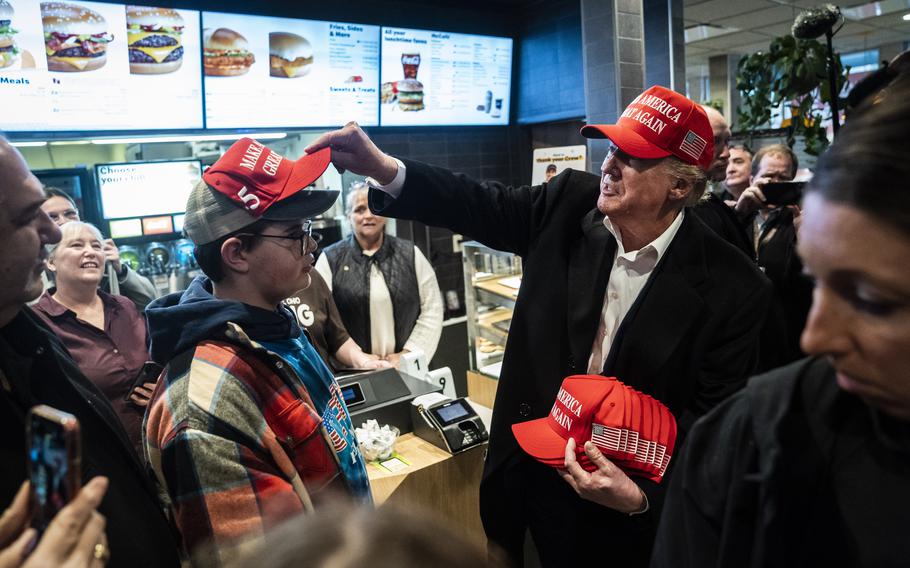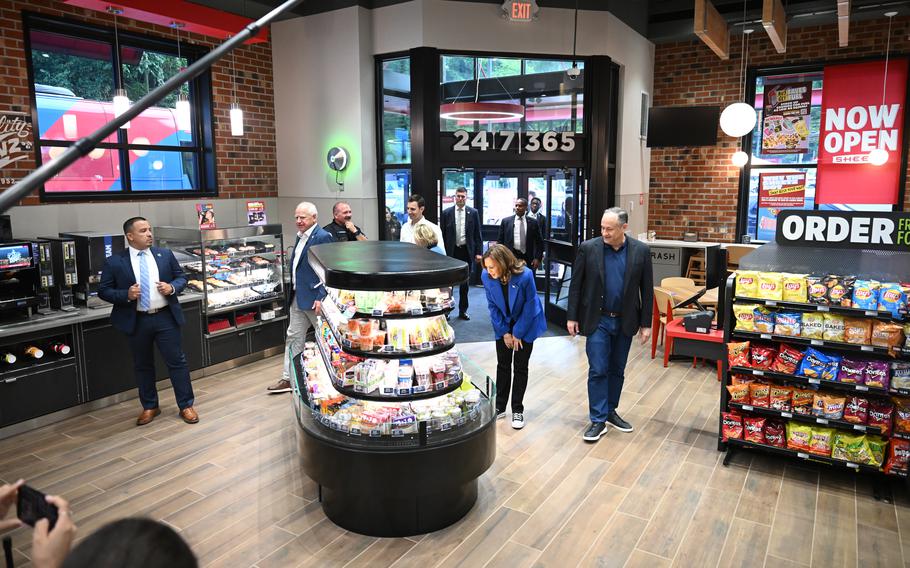
Former president Donald Trump hands out MAGA hats at McDonald’s last year in East Palestine, Ohio. His campaign is responsible for virtually all the $35,900 federal candidates have spent at the fast-food chain since January 2023 — $31,000 or about 86%. Overall, Republicans have spent about 28 times as much as Democrats at the Golden Arches, a Washington Post analysis shows. (Jabin Botsford/The Washington Post)
Earlier this year, a reporter at NBC News posted on X that she’s “not sure [she] will ever recover from learning” that a colleague gets restaurant recommendations from Federal Election Commission filings, the periodic reports that reveal how candidates for Congress and the White House spend their campaign dollars.
Her colleague tweeted in reply: “If one of the 535 people who run our legislature is gonna spend thousands of dollars at a barbecue place I’ve never heard of, you better believe I’m gonna go to there.”
Immediately, we had questions.
Do political campaigns know something about America’s restaurant scene that we don’t? Do Republicans and Democrats dine differently?
Thus began our effort to glean gems of dining wisdom from the seemingly mundane depths of the nation’s campaign finance reports.
First, we scoured the reports for every food-related receipt filed between January 2023 and Sept. 20, 2024, turning up bills for everything from coffee runs to high-dollar catered affairs. With a little spade work, we found evidence that food has played a starring role at key moments in the race — like the late-night order Vice President Kamala Harris put in for Andy’s Pizza in D.C. the night President Joe Biden dropped out and endorsed her (a detail first reported by the New York Times and confirmed in our analysis).
But we wanted to wrap our arms around a bigger question: where the campaigns spend the most money. We limited our analysis to places that racked up at least $5,000 in campaign spending, coming up with a list of roughly 500 popular restaurants and food purveyors, involving more than 21,000 receipts worth a collective $13 million.
So where do the major candidates like to eat?
For Trump, the answer is frequently McDonald’s. His campaign is responsible for virtually all the $35,900 federal candidates have spent at the fast-food chain since January 2023 — $31,000 or about 86%. Overall, Republicans have spent about 28 times as much as Democrats at the Golden Arches, our analysis shows — revealing the Big Mac and the Egg McMuffin as some of the most polarized menu items in American politics.
Republican campaigns also showed a huge preference for Chick-fil-A, spending more than $200,000 at the Atlanta-based fried chicken chain with Christian roots — about 20 times more than Democrats.
Fast-food in general appears to be a Republican thing: Overall, GOP campaigns outspent Democrats about 18-to-1 at fast-food joints of all stripes. For the Democratic presidential campaigns, the single-most popular fast casual chain during this period was Panera Bread, where Biden and Harris spent over $7,000.
When the campaigns go with fast casual, Republicans and Democrats also go in different directions. Republicans spent more money at Shake Shack, Qdoba and the sandwich joint Jimmy John’s while Democrats are responsible for the majority of campaign spending at Sweetgreen, Corner Bakery and Le Pain Quotidien, a bakery chain known for its quiche and tartines. Mediterranean fast casual seems to provide neutral ground, with campaigns from both parties spending a similar amount at Roti and Cava.

Vice President Kamala Harris makes a stop at a Sheetz gas station on Aug. 18 in Corapolis, Pa. Fast-food in general appears to be a Republican thing: Overall, GOP campaigns outspent Democrats about 18-to-1 at fast-food joints of all stripes. For the Democratic presidential campaigns, the single-most popular fast casual chain during this period was Panera Bread, where Biden and Harris spent over $7,000. (Matt McClain/The Washington Post)
Then there’s coffee. On first glance, you might think there’s a big Starbucks-Dunkin’ divide: About two-thirds of Starbucks spending came from Democrats while about the same share of Dunkin’ spending came from Republicans. However, we found that Starbucks was the runaway winner among all campaigns, with total spending at the Seattle-based chain roughly double the outlay at Dunkin’.
Though some foods transcend party — Republicans and Democrats spent similar amounts on Italian, French and fast casual food — the filings suggest that partisan taste buds differ in important ways. For example, Republicans spent more than twice as much as Democrats on barbecue (or barbeque or bar-b-que or BBQ, as the filings variously describe it).
Democrats, on the other hand, were responsible for nearly all the campaign spending at sports stadiums and arenas, particularly Nationals Park in D.C. They also handily outspent Republicans on Mexican, Spanish and Chinese food.
Perhaps to no one’s surprise, American food turned out to be the single-most popular choice. From Ted’s Bulletin in D.C. to southern Mississippi’s Patio 44, we found that campaigns spent about $2.8 million at “American” restaurants — about 20% of all campaign food spending in our analysis.
Steakhouses rank as the top restaurant choice for Republicans and the third most popular among Democrats. But candidates appear to have brand preferences: The Brazilian roasted-meat chain Fogo de Chão was popular with both parties, while the more solidly American Ruth’s Chris and Longhorn steakhouses were more popular among Republicans.
What about food delivery, you ask? Overall, the campaigns spent nearly $360,000 on Uber Eats, DoorDash, Instacart and Grubhub. But Democrats were much more likely to use those platforms, outspending Republicans by more than $80,000.
In addition to cuisine, location obviously plays a role in where campaigns choose to dine. One of the top spenders, House Majority Leader Steve Scalise (R-La.), has preferences matching his New Orleans roots: On multiple occasions, his campaign patronized Drago’s Seafood Restaurant (founded in Louisiana in 1969) and Aunt Sally’s Pralines (the New Orleans-based candy store). His campaign also once visited Randazzo King Cakes, which is known for their Mardi Gras delights.
But a little more than half of all the spending we analyzed — about $7.5 million — occurred in D.C., with the absolute most popular restaurants located not far from lawmakers’ offices in the U.S. Capitol complex.
Capital Grille on Pennsylvania Avenue is a mere six blocks away. Campaigns — mostly Republicans — have made more than 600 visits and spent more than $570,000 at the stately steakhouse at the D.C. location and another $80,000 at other locations around the country. The second-most popular was Charlie Palmer Steak — especially its location a block north of the Capitol — where the campaigns spent over half a million dollars.
When campaigns venture further afield, they tend to favor Italian: RPM Italian, Trattoria Alberto, Carmine’s, L’Ardente and Osteria Morini on the Anacostia waterfront all rank among the top 15 restaurants in D.C.
All this data work left us hungry, so we asked Washington Post food critic Tom Sietsema whether we should we make like that NBC reporter and follow the campaign money to pick our next restaurant.
“I would not,” Sietsema replied rather firmly. “If you went by this [list], you might see a politician or 15, but you would miss the world. Where’s the Chinese? Where’s the West African? Where’s the Japanese?”
It turns out hungry campaign staffers tend not to have adventurous palates. “It’s just such a narrow slice and range of tastes,” Sietsema said.